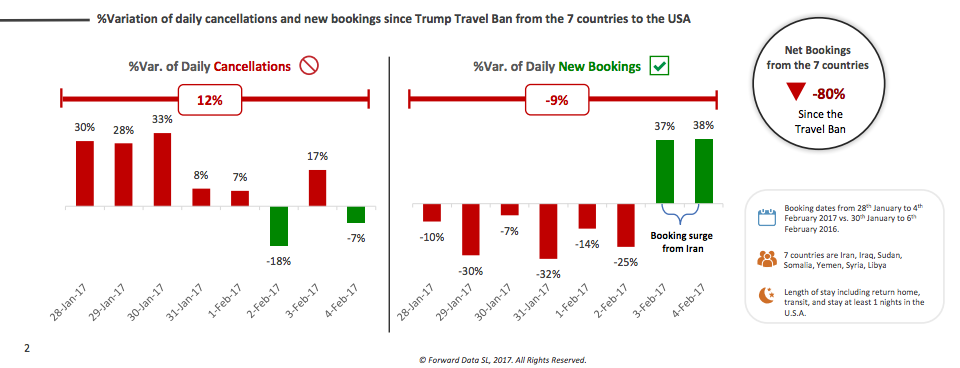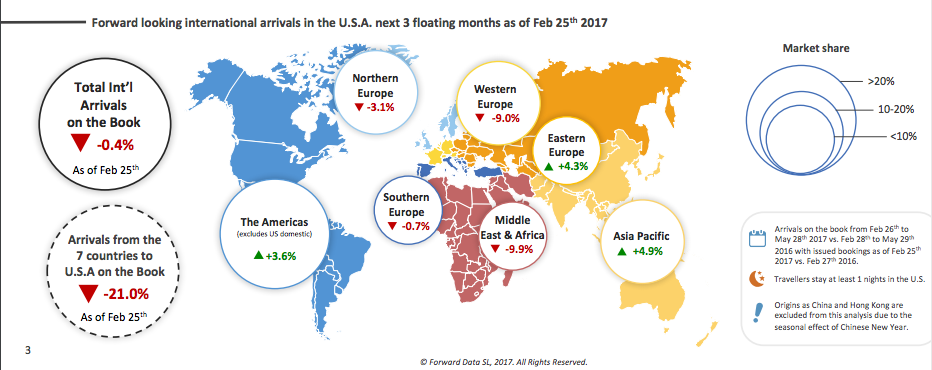Following President Donald Trump’s travel ban, bookings for travel from the U.S. to the Middle East have decreased notably, according to ForwardKeys, a company that monitors future travel patterns by analyzing flight reservations.
“The travel ban has not only impacted travel from the seven affected countries to the U.S., as one would expect; it has also affected travel in the opposite direction, too,” Olivier Jager, CEO of ForwardKeys, said in a statement. “At this point, we do not know why, exactly, but we suspect that United States citizens may be avoiding travel to Islamic countries, fearing that they will not be welcome or that Muslims based in the United States may be avoiding travel fearing re-entry problems or both. Nevertheless, whilst we cannot be sure of the cause, the effect, a 27-percent collapse in bookings to the Middle East, is substantial.”
Notably, the information was sent by email to Lindsay Walters, the White House deputy press secretary, on Friday, March 3 at 11.03 am EST by Tarsh Consulting, ForwardKeys’ PR adviser. On Monday morning, the President signed a new ban in spite of the evidence that restricting travel could disrupt the country's travel-based economy.
“The information provided to the White House makes it clear that the travel ban has damaged the U.S. travel industry,” Jager said. “There has been a 39-percent meltdown in travel to the Middle East and when the ban was first announced, there was a 6.5 percent slump in bookings to the USA. The slump was reversed when the courts struck down the ban but Donald Trump’s promise of a new ban has triggered a second 4 percent slump.”
He continued: “When Donald Trump issued the first travel ban, he did not have access to ForwardKeys’ data; however, we sent our analysis to Lindsay Walters personally on Friday, so it would be reasonable to assume Donald Trump’s administration was aware of our findings before implementing the new ban.”

The initial travel ban on people from the seven Muslim-majority countries—Iraq, Syria, Iran, Sudan, Libya, Somalia and Yemen—had a much wider impact than expected, as total international travel to the U.S. fell 6.5 percent following the executive order. The intervention by the courts a week later to strike down the ban helped briefly, but bookings to the U.S. slumped again when President Trump promised a new ban. Bookings for future arrivals are effectively flat.
Before & After
For the three weeks before the ban was signed, accumulated U.S. bookings to the Middle East were up by a very healthy 12 percent over last year. In the four weeks following the ban, however, they were down 27 percent, a 39-percent decrease year-over-year.
South Asia suffered a similar fate: Prior to the travel ban, bookings were up 12 percent, but dropped 24 percent, a 36-percent reversal. (ForwardKeys’ geographic definition, following UNWTO, puts Iraq, Yemen and Syria in the Middle East and Iran in South Asia). As a benchmark, total outbound bookings from the U.S. made during the peak January booking season, prior to the imposition of the travel ban, were 17 percent up on last year—"unusually healthy," according to the company, which suggested that the surge was driven by travelers seeking an alternative to Europe. In the four weeks after the imposition of the ban, the rise in total outbound bookings had fallen back to 4.4 percent.
The Next Three Months: Outbound
As of Jan. 27, forward bookings for travel to the Middle East were 23 percent ahead of the same point last year, but by Feb. 28, they had fallen 2.4 percent behind, a 25.4-percent slowdown. Bookings for travel to South Asia during the March-May period were 8.8 percent ahead prior to the imposition of the ban; by Feb. 28, they were 6.6 percent behind, a 15.4-percent slowdown. As a benchmark, overall U.S. outbound travel for the next three months is, as of Feb. 28, a "very healthy" 11 percent ahead, but prior to the ban it had been an even healthier 20 percent ahead, a 9-percent slowdown.
Whether the overall slowdown in forward bookings was caused by the travel ban is debatable—it could simply be the consequence of an unusually strong peak booking season in January. However, the collapse in bookings to the Middle East is very difficult to explain without reference to the travel ban.
Inbound Travel
Looking more closely at total international travel to the U.S., ForwardKeys data show that the announcement of the travel ban on Jan. 27 caused a 6.5-percent slump in bookings to the country in the following eight days. However, when the ban was struck down by the courts on Feb. 4, there was a recovery: During the 12 days after that, bookings rose to 2.2 percent over the same period last year.

But, as soon as plans for a new ban were announced on Feb. 17, bookings again fell and in the nine days after, they were 4 percent down on the equivalent period last year. Travel to the U.S. is particularly down from the Middle East, Europe and Africa.
The Next Three Months: Inbound
Looking ahead, forward bookings for total international arrivals in the U.S. during the next three months are currently 0.4 percent behind where they were at the same time last year. Inbound travel from Europe, the Middle East and Africa is significantly behind, whereas travel from Asia Pacific and the Americas is ahead. As a benchmark, on Jan. 27, the day before the imposition of the travel ban, three-month forward bookings were 3.4 percent ahead.
“Donald Trump’s on-off travel ban has created a roller-coaster ride for the travel industry,” Jager said. “Some passengers do not know where they stand as they await President Trump’s promised new order. It’s not at all clear when that will come. In the meantime, uncertainty reigns and the presidential rhetoric appears to be deterring visitors to the U.S.”
